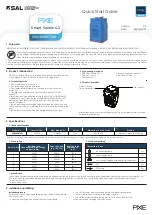
276
AES
APS
Aggregation
ARP
ARP Inspection
Auto-Negotiation
C
CC
CCM
CDP
D
DEI
DES
AES is an acronym for Advanced Encryption Standard. The encryption key protocol is
applied in 802.1i standard to improve WLAN security. It is an encryption standard by
the U.S. government, which will replace DES and 3DES. AES has a fixed block size of
128 bits and a key size of 128, 192, or 256 bits.
APS is an acronym for Automatic Protection Switching. This protocol is used to
secure that switching is done bidirectional in the two ends of a protection group, as
defined in G.8031.
Use multiple ports in parallel to increase the link speed beyond the limits of a port
and to increase the redundancy for higher availability (also Port Aggregation and
Link Aggregation).
ARP is an acronym for Address Resolution Protocol. It is a protocol that used to
convert an IP address into a physical address, such as an Ethernet address. ARP
allows a host to communicate with other hosts when only the Internet address of its
neighbors is known. Before using IP, the host sends a broadcast ARP request
containing the Internet address of the desired destination system.
ARP Inspection is a secure feature. Several types of attacks can be launched against a
host or devices connected to Layer 2 networks by "poisoning" the ARP caches. This
feature is used to block such attacks. Only valid ARP requests and responses can go
through the switch device.
Auto-negotiation is the process where two different devices establish the mode of
operation and the speed settings that can be shared by those devices for a link.
CC is an acronym for Continuity Check. It is a MEP functionality that is able to detect
loss of continuity in a network by transmitting CCM frames to a peer MEP.
CCM is an acronym for Continuity Check Message. It is an OAM frame transmitted
from a MEP to its peer MEP and used to implement CC functionality.
CDP is an acronym for Cisco Discovery Protocol.
DEI is an acronym for Drop Eligible Indicator. It is a 1-bit field in the VLAN tag.
DES is an acronym for Data Encryption Standard. It provides a complete description
of a mathematical algorithm for encrypting (enciphering) and decrypting
(deciphering) binary coded information.













































